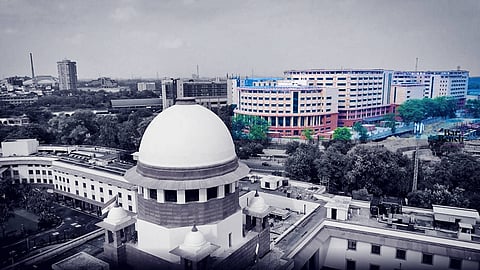
- Latest Legal News
- News
- Dealstreet
- Viewpoint
- Columns
- Interviews
- Law School
- Legal Jobs
- हिंदी
- ಕನ್ನಡ

The Chief Justice of India rightly remarked that January 28th should be celebrated, as it was on this day that the Supreme Court of India first assembled in the Court Chambers in Parliament.
On January 26, 1950, the Supreme Court stood established under Article 124 of the Constitution, but its first sitting was on January 28th. It was a glittering ceremony, and a photograph published by The Hindu on January 29th,1950 shows the first six justices of the Supreme Court on the dais: Justices S.R.Das, M.C. Mahajan, S. Fazl Ali, H.J. Kania, M. Patanjali Sastri, and B.K. Mukherjea.
It is equally important to note the 13 Chief Justices from various High Courts who are sitting below the dais. Of particular importance is the photograph of Chief Justice Vivian Bose, who was soon to join the Supreme Court and, till this date, remains one of the finest writers of judgments. It is also interesting to see Chief Justice M.C. Chagla of the Bombay High Court and Chief Justice Rajamannar of the Madras High Court.
The Hindu news report also mentioned that Prime Minister and the Deputy Prime Minister (Nehru and Patel) and the other cabinet ministers attended the ceremony in addition to the Advocates-General of various States, and the Commanders-in-Chief of the three services. Amongst the retired judges was Sir Maurice Gwyer who had been the Chief Justice of the Federal Court and then the Vice-Chancellor of the Delhi University and Sir S. Varadachariar, who was a former judge of the Federal Court and a truly outstanding jurist.
The Federal Court was the predecessor of the Supreme Court and had come into being on December 1937. It had limited jurisdiction but did deliver several landmark rulings. At the inauguration, the first Attorney-General of India, M.C. Setalvad, remarked that the jurisdiction and power of the new Supreme Court were wider than those exercised by the highest courts of any country in the Commonwealth or by the Supreme Court of the United States. He also stressed the importance of fundamental rights which were enshrined in Part III of the Constitution. The first Chief Justice Sir H. J. Kania complimented the Privy Council and observed that its decisions would be treated with the greatest respect as they had become a part of the law in our country. The decisions of the Privy Council were “monuments of learning” and were written with illuminating clarity and the lucid exposition of first legal principles.
It is also significant that Chief Justice Kania hoped that the convention that prevailed before January 26, 1950, that no High Court judge would be appointed if the Chief Justice did not approve the appointment, would continue. Justice Kania also mentioned that the Supreme Court would be aloof from party politics and would be aligned to none.
Origins of the Supreme Court
From “Supreme Court of India - The Beginnings” by George H. Gadbois and edited by Vikram Raghavan and Vasujith Ram, one learns that Sir Hari Singh Gour first mooted the idea for a Supreme Court of India in 1921 when he introduced a resolution in the Central Legislative Assembly for creating a court of ultimate appeal for India. Gadbois points out that while Muhammad Ali Jinnah embraced the proposal, Motilal Nehru and Tej Bahadur Sapru had opposed it. Under the Government of India Act, 1935, the Federal Court was set up which had its first sitting in December 1937 in the Chamber of Princes.
When the Constituent Assembly was formed, the ad hoc committee to make recommendations for an independent judiciary for India was headed by Sir S. Varadachariar, former Federal Court Judge and the other Committee Members included Sir Alladi Krishnaswami Ayyar and Sir Brojendra Lal Mitter from Madras and Calcutta, respectively. Most of the recommendations of this committee were accepted by the Constituent Assembly.
Although the Supreme Court started functioning on January 28, 1950, Gadbois points out that the Supreme Court Building was completed in 1958 under the supervision of Ganesh Deolalikar. It is ironic that Edwin Lutyens’ plans for the capital city did not provide for building a court.
Over the last 71 years, the Supreme Court of India has rendered several landmark judgments. As in any institution, there have been ups and downs, and one hopes that the coming decades would also see important principles being laid down. It is perhaps necessary to commemorate or celebrate January 28 as “Supreme Court Day”.
The author is Arvind Datar, a Senior Advocate.